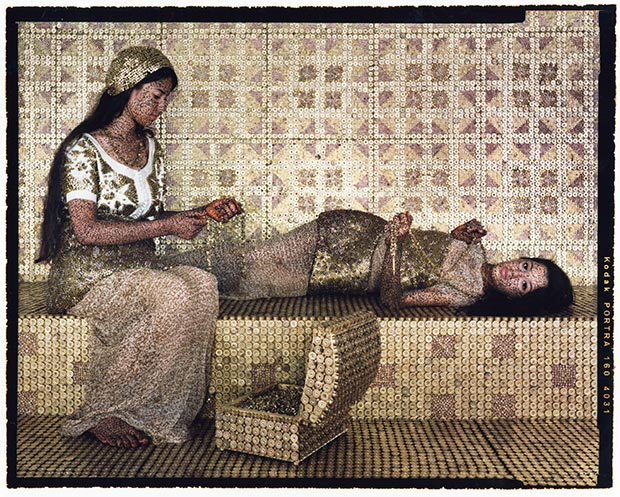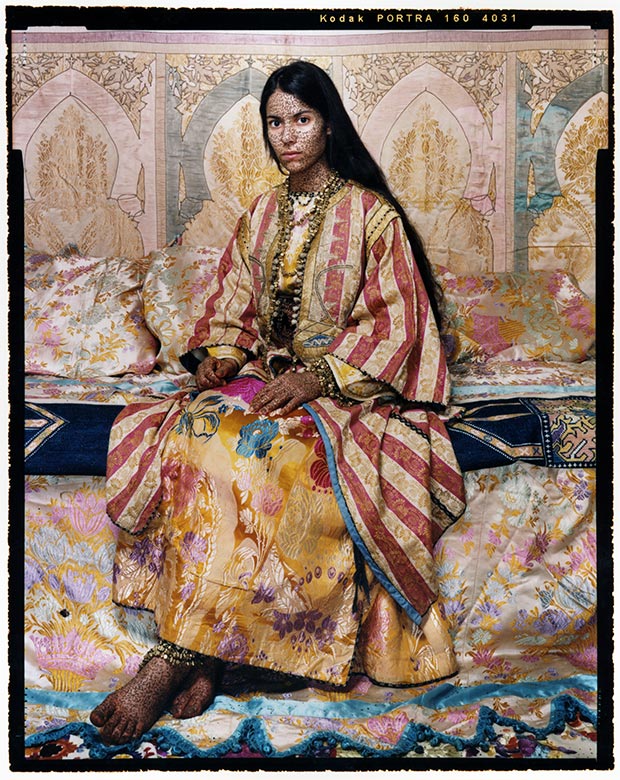
Lalla Essaydi’s retrospective exhibition at Kashya Hildebrand London Beyond Beauty
Oct 22, 2013 Exhibition

 Lalla Essaydi / Bullets Revisited #8, 2012. Chromogenic print mounted to aluminium with a UV protective laminate. 76.2 x 101.6 cm. Print number 2 of an edition of 15 / Courtesy Kashya Hildebrand and Edwynn Houk Gallery
Lalla Essaydi / Bullets Revisited #8, 2012. Chromogenic print mounted to aluminium with a UV protective laminate. 76.2 x 101.6 cm. Print number 2 of an edition of 15 / Courtesy Kashya Hildebrand and Edwynn Houk Gallery
Currently based in the USA, Essaydi returns to her Moroccan girlhood through her work, looking back on it as an adult woman caught somewhere between past and present, and as an artist, exploring the language in which to "speak" from this uncertain space. She employs photography intersected with an array of artistic media and practices extending from installation to calligraphy and henna painting in her attempt to challenge Orientalist readings of Arab female identity. In this sense, Beyond Beauty documents how the artist constructs beauty through the assumption of tradition and the past and how she reaches through the windows of history, gender, architecture and culture.
Essaydi seeks to challenge our notions of history, gender, architecture and culture and the role that women inhabit in traditional Orientalist fantasies within them. Essaydi uses the recurrent iconography of the harem, which she deconstructs in her attempt to provide a revised reading of archetypical conceptions. The area of the harem corresponds to the private portion of the house, meant to accommodate the everyday life of the family’s female members and prevent encounters with men alien to the family.
She also uses intricate calligraphic text using henna instead of ink to fill everything from the walls to the fabrics her Odalisques wear. The henna painting comes to elaborately conceal the uncovered parts of the female bodies and in this sense assumes an allegorical dimension: even their bare skin becomes her canvas as she covers their ankles, legs, arms, wrists and faces in row upon row of tight script. What is key here is that the art of calligraphy itself is traditionally a male-dominated realm, yet Essaydi takes it and uses it with the ultra-feminine medium of henna dye (used by women to create decorative patterns for special occasions such as weddings). "By reclaiming the rich tradition of calligraphy and interweaving it with the traditionally female art of henna," she explains, "I have been able to express, and yet, in another sense, dissolve the contradictions I have encountered in my culture: between hierarchy and fluidity, between public and private space, between the richness and the confining aspects of Islamic traditions."
 Lalla Essaydi / Bullets Revisited #15, 2012. Chromogenic print mounted to aluminium with a UV protective laminate. 101.6 x 76.2 cm. Print number 1 of an edition of 15 / Courtesy Kashya Hildebrand and Edwynn Houk Gallery
Lalla Essaydi / Bullets Revisited #15, 2012. Chromogenic print mounted to aluminium with a UV protective laminate. 101.6 x 76.2 cm. Print number 1 of an edition of 15 / Courtesy Kashya Hildebrand and Edwynn Houk Gallery
 Lalla Essaydi / Harem Revisited #38, 2012. Chromogenic print mounted to aluminium with a UV protective laminate. 152.4 x 121.9 cm. Print number 1 of an edition of 10 / Courtesy Kashya Hildebrand and Edwynn Houk Gallery
Lalla Essaydi / Harem Revisited #38, 2012. Chromogenic print mounted to aluminium with a UV protective laminate. 152.4 x 121.9 cm. Print number 1 of an edition of 10 / Courtesy Kashya Hildebrand and Edwynn Houk Gallery
Elsewhere, female figures ensconced in lavishly adorned kaftans, which reproduce the decorative motifs of the building’s facades, pose as muted ‘odalisques’ against the photographic lens. Through this combined use of space, calligraphy, henna and costume, Essaydi explores the function of women as decorative features within the context of vernacular architecture. Adds Essaydi, "The women then, become literal odalisques (odalisque, from the Turkish, means to belong to a place)." As such, she is portrayed ‘caged’ amongst other acquisitions in the ‘cabinet de curiosite’ of the male dominion, the harem. This very physical and psychological environment of the home and harem haunts the artist, in the sense that it constitutes the space and the culture of her childhood within her.
In her latest series, we see a change in aesthetics, moving away from the bounds of traditional architectural spaces to a new Byzantine-like luxury. In Beyond Beauty, the works on display from the series Bullet and Bullets Revisited, showcase beautiful Odalisques adorned in shimmering materials against equally dazzling mosaic backdrops, giving an aura of warm-hued wealth and luxury. Upon closer inspection, however, every item, from clothing to the walls, is made up of carefully cut and polished bullet casings. These deadly, violent objects from contemporary society are juxtaposed with Essaydi’s classical scenes, rendering them objects of beauty within these delicate tableaux. Here, Essaydi has lifted her veiled beauties out from their backdrops of soft fabrics and made her women resplendent, very much at the forefront, glittering and glimmering in all their glory.
 Lalla Essaydi / Harem #2, 2009. Chromogenic print mounted to aluminium with a UV protective laminate. 76.2 x 101.6 cm. Print number 5 of an edition of 15 / Courtesy Kashya Hildebrand and Edwynn Houk Gallery
Lalla Essaydi / Harem #2, 2009. Chromogenic print mounted to aluminium with a UV protective laminate. 76.2 x 101.6 cm. Print number 5 of an edition of 15 / Courtesy Kashya Hildebrand and Edwynn Houk Gallery
Lalla A. Essaydi (1956) grew up in Morocco and now lives in USA where she received her MFA from the School of the Museum of Fine Arts/TUFTS University in May 2003. Recent solo exhibitions include Lalla Essaydi: Boundaries at the Amelia Johnson Contemporary, Hong Kong, China (2013); Lalla Essaydi: Revisions, a Retrospective, at the Smithsonian African Museum of Art, Washington DC (2012) and Les Femmes du Magreb at the Orientalist Museum, Doha, Qatar (2012). Her work can be found in the collections of the The British Museum, The Louvre, Los Angeles County Museum of Art, Arab Museum of Modern Art, Qatar and The Art Institute of Chicago. Essaydi’s photographs can be found in publications such as Arab Photography Now (2012), Les Femmes du Maroc (2009) and the Encyclopedia of Arab American Artists (2007). Her art, which often combines Islamic calligraphy with representations of the female body, addresses the complex reality of Arab female identity from the unique perspective of personal experience.
Kashya Hildebrand opened her first gallery in Geneva in 2001 and later had galleries in both New York and Zurich. In June 2013, Kashya opened its London space on Eastcastle Street with the inaugural exhibition of Iranian artist Reza Derakshani. Hildebrand’s programme reflects its dedication to the support and the representation of an international group of emerging and mid-career artists through solo and group shows.
Comments
Add a comment